A Multicolored Starscape: Using Mobile Astronomy Apps to Explore the Stars

Pleasant spring evenings are fine times to get outside, look up and enjoy the night sky. The prominent constellations of winter — Orion, Taurus and Auriga — linger in the west for a few hours after dark. Over in the eastern sky, the summer star party favorites of Boötes, Hercules, Vega and Cygnus are visible for late-evening and night-owl stargazers. In this edition of Mobile Astronomy, we'll take a closer look at stars: how they are named and how to use your favorite mobile app to pick out some famous ones and see with your own eyes that they shine with a rainbow (well, spectrum, actually) of colors!
What's in a name?
Of the thousands of stars bright enough to be seen with unaided human eyes, only the brightest few hundred have been given proper names. For the most part, modern astronomy has adopted the Arabic star names that were coined by ancient astronomers in the Middle East, or used Greek and Latin names already in use. During the second century, the Greek astronomers Hipparchus and Ptolemy used versions of those names to publish catalogues of bright stars and constellations that were visible from that part of the world, meaning about half the sky. The majority of those constellations were named for Greek and Roman gods, and for animals.
As travelers saw the rest of the world, and new skies, in the following centuries, more constellations were added to the 48 in Ptolemy's catalogue. After the global voyages of the 17th and 18th centuries, even more constellations were added, mainly around the south celestial pole. Nowadays, the International Astronomical Union (IAU) officially recognizes 88 constellations. Each has a defined boundary, so that altogether, the 88 constellations cover the entire celestial sphere without gaps or overlap. Your sky-charting app will organize the sky by constellation, often using a three-letter abbreviation for each one, e.g., Ori for Orion and CMa for Canis Major. Some apps, such as SkySafari, give the option of displaying the constellation boundaries. [The Best Night-Sky Events of 2016: What to Watch for This Year]

Many of the proper star names are descriptive. The star Rigel, which marks the western foot of Orion, means "the Foot" (for obvious reasons). In contrast, the star at Orion's other foot is named Saiph, "the giant's sword," a name that was originally intended for another star. Some star names are merely descriptive. The name of Orion's neighbor Sirius, the brightest star in the night sky, means "the brilliant or scorching one," and the reddish star Antares, currently near Mars in the morning sky, has a name that means "rival of Mars."
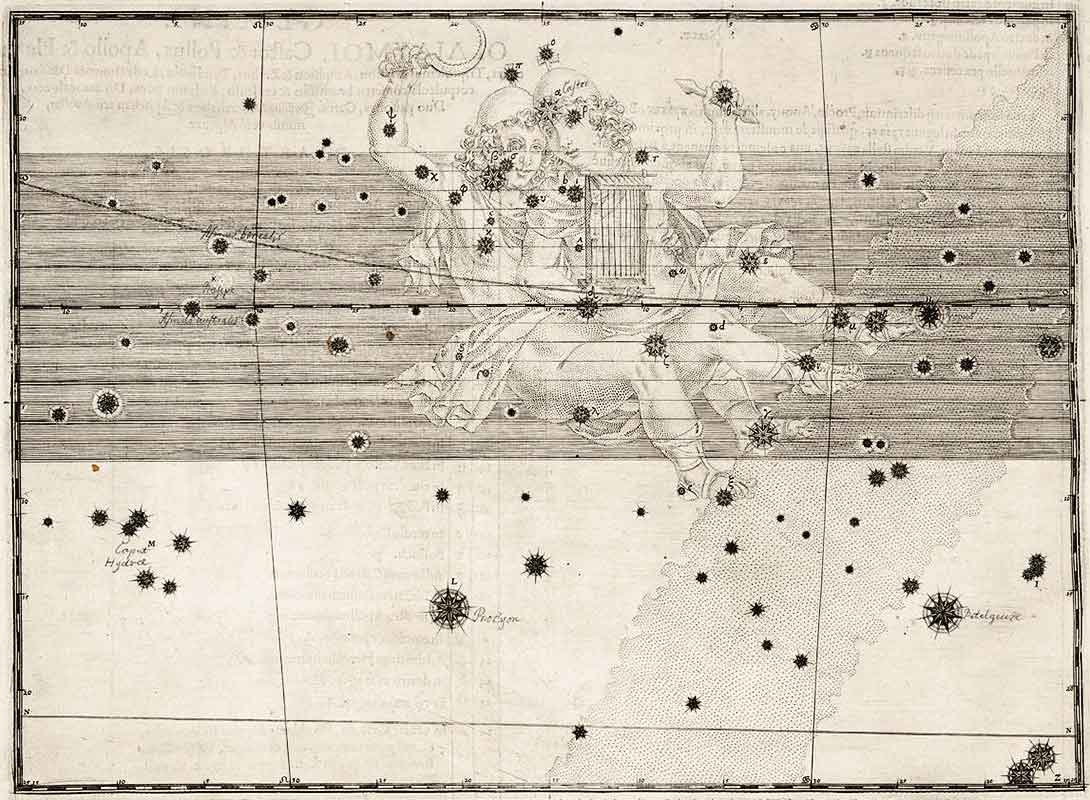
For the many remaining naked-eye stars that lack proper names, astronomers and mobile apps use other naming systems. In 1603, Johann Bayer of Germany published his "Uranometria" catalogue, which labeled the brightest stars in each constellation in approximate order of brightness. The top 24 stars are labeled using the Greek alphabet, from Alpha all the way down to Omega. Our friend Sirius is also known as Alpha Canis Majoris, or α CMa.
If the constellation contained more than 24 stars, the rest next batch was labeled with lowercase Roman letters: a, b, c, etc., but omitting j and v. Modern astronomy has adopted and expanded the Bayer system. Fainter stars he was unable to see are labeled with capital Roman letters: A, B, C, and so on. In this way, about 2 thousand stars are tabulated. The system is not perfect: Some stars were shared between two different constellations or were later transferred into neighboring constellations, so there can be gaps in the series.
Around the time of Isaac Newton, in the early 1700s, the Flamsteed designation system was published based on a star catalogue by astronomer John Flamsteed. This time, for each constellation, the stars were numbered, in order, using their positions from west to east. This system allowed for labeling the dimmer stars that Bayer missed. The Flamsteed system now includes about 2,500 stars, but the Bayer designation is usually given priority in apps and star charts because it so easily indicates which stars are brightest. A second reason is that, over decades and centuries, the stars change positions, and so the Flamsteed system no longer numbers them correctly.
Breaking space news, the latest updates on rocket launches, skywatching events and more!
For binocular and telescope users, most of the better sky-chart apps include far more stars than you can see with the naked eye, ranging from 100,000 stars to 24 million, depending on the app. Those stars are extracted from the professional indexes of the Smithsonian Astrophysical Observatory (SAO), Harvard Observatory's Henry Draper Catalogue (HD) and the Hipparcos Satellite Catalogue (HIP). In your mobile app, some of the stars of interest to astronomy enthusiasts can only be searched for using these designations, but these designations include some gems — stars with confirmed exoplanets; dim, deep red carbon stars; and more. The same codes are used in most computerized telescopes. In a future column, we'll cover linking your mobile device to your telescope. [Gallery: Amazing Skywatcher Photos from Around the World]
Stars in color!
Each star radiates a particular color of the rainbow. There are red giants, which are on the verge of shedding their outer layers into space; blue supergiants like Rigel in the constellation Orion, which could potentially go supernova; and ordinary yellow stars like Earth's sun, which might be stable and warm enough to support life. So the next time you're out on a clear evening, pay special attention to the color of individual stars.
While virtually all stars have intensely hot cores fusing atoms at millions of degrees, the stars' surface temperatures vary depending on the stars' masses, ages and compositions. That temperature lends a unique spectral color to each star's light.
Here's a good analogy: If you apply heat to a metal, its color changes as it warms up, moving from a dull red, though orange and yellow, then brightening to white, and ending up as the blinding blue-white light that welders need protection from.

Every hot body glows with a range of colored light, but at a given temperature the brightest light will peak at a certain wavelength, or color, of light. Curves that illustrate the relative distribution of light are called blackbody curves. Stars shine over the same range of visible light that the heated metal does, with cooler stars appearing red and usually dim, the hottest stars a bright blue-white and the others, like Earth's yellowish sun, falling somewhere in the middle.
Astronomers have created a classification system that is tied to the color of a star's light, and therefore the star's temperature. The spectral classes have been given letter designations. The original naming system — of A, B, C, D, etc. — had to be adjusted as more discoveries were made and the system was refined. The result is the modern set of letters — O, B, A, F, G, K, M — which can be remembered by mnemonic phrases such as "Oh, Be A Fine Girl/Guy, Kiss Me." The O-class stars are the hottest, with surface temperatures up to 30,000 degrees Kelvin (53,540 degrees Fahrenheit or 29,727 degrees Celsius), and the M-class stars are the coolest, with temperatures around 2,500 degrees K (4,040 degrees F or 2,227 degrees C). (Kelvin is the equivalent to Celsius, but with 0 degrees pinned at absolute zero. All temperatures mentioned below are in Kelvin.)
Following our welding analogy, the O stars are brighter and the M stars dimmer, bordering on invisible to human eyes and telescopes. That's why the brightest stars in our favorite constellations are usually the blue-white ones. M-type stars comprise 80 percent of the stars in this galaxy; they are so commonplace because they burn slowly and live a long time, up to 200 billion years! Earth's friendly yellow sun is in the middle range, a G type star with a surface temperature of 5,800 degrees K (9,980 degrees F or 5,527 degrees C) and a life span of 10 billion years. Of course, the sun is so close and so bright that Earthlings perceive the star as white. [Stunning NASA Video Shows 3 Years of the Sun in 3 Minutes]
To account for stars that fall between two letters, a numeral — from 0-9 — is appended. Thus an A8 star is nearly as cool as an F star. Finally, a code using Roman numerals is appended to indicate the star's size. Supergiant stars like Rigel and Deneb are Ia types, and normal giant stars like Arcturus and Aldebaran are type III. Earth's sun is a regular-size G2V-type star.
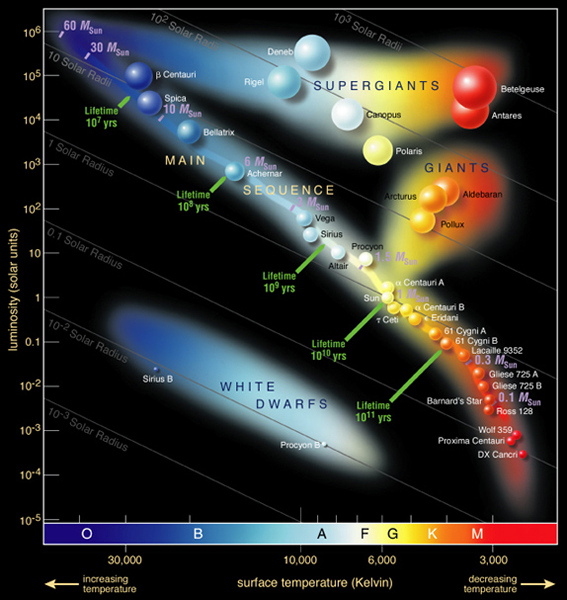
All sky-charting apps color-code the star symbols according to the stars' stellar classifications. Clicking on the star brings up information with the star's various names and designations, visual magnitude (how bright it appears), spectral class, distance away, mass, and more. The major stars often also have a page of written information about the star's evolution, folklore and physics. Some apps use Wikipedia links to summon the extra information, requiring a live-data or Wi-Fi connection.
By the way, even though green falls between blue and yellow on the spectrum, human eyes are not capable of isolating green photons without also triggering the red and blue receptors. Earth's sun emits light that peaks around the green part of the spectrum, but human eyes will only see sunlight as white. So there are no green stars in the sky — to human eyes, anyway.
Next up, I'll describe some easy-to-find springtime stars of each class for you to try your observing skills on. With your mobile app in compass or augmented-reality mode, simply move your display around to match up the brighter stars, or use the search key, and let your app tell you where to look. [The Brightest Stars in the Sky: A Starry Countdown]
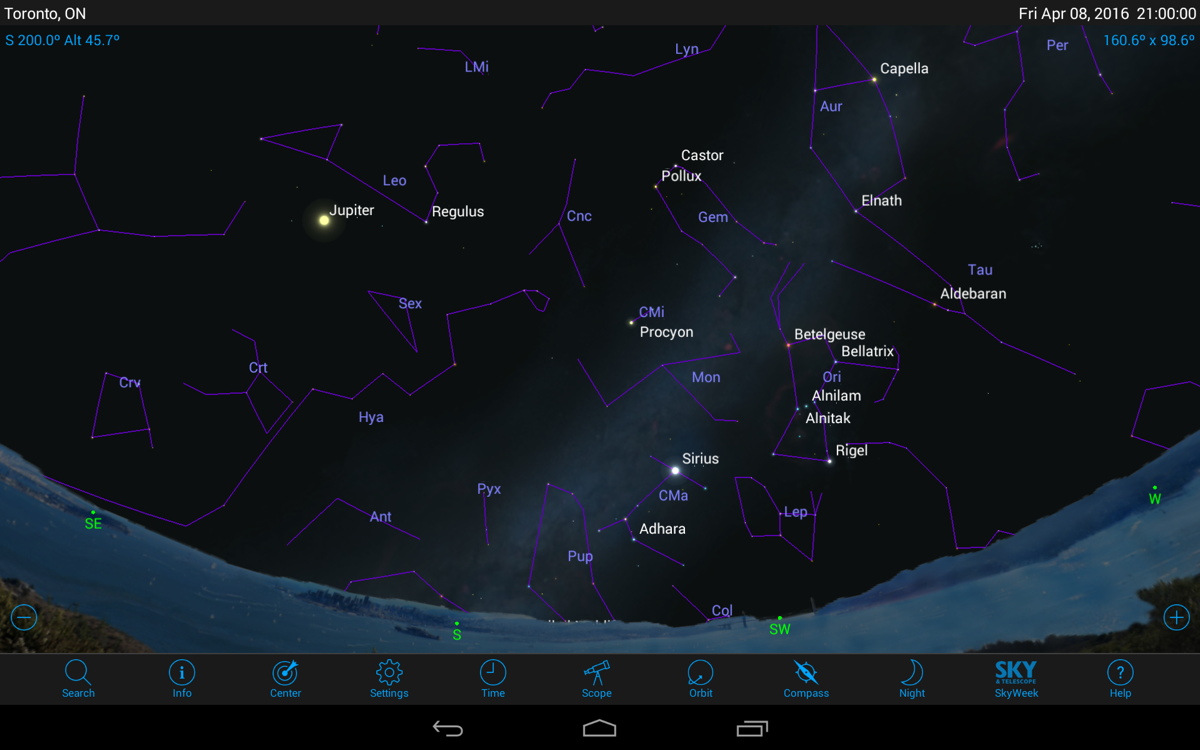
Using Your App to See for Yourself
Betelgeuse (or α Ori) is the bright star marking Orion the Hunter's eastern shoulder. It's a "cool," M2Ib-class red supergiant star located about 600 light-years away, with a surface temperature of 3,500 degrees K (5,840 degrees F or 3,227 degrees C). It's old for such a massive star, about 7 million years in age, and it's expected to blow up in a violent supernova explosion at any time. In fact, this may already have happened but the light hasn't arrived yet! Betelgeuse is red now due to its age and enormous mass, not because it formed as an M-star. If that star were placed in this solar system, all the inner planets and the asteroid belt would be inside the star. It's so large that, unlike most stars, it takes up a measureable angle in the sky, and the Hubble Space Telescope was able to image the star's disk. Compare Betelgeuse to the other bright stars in the area, and you'll readily notice its reddish tint.
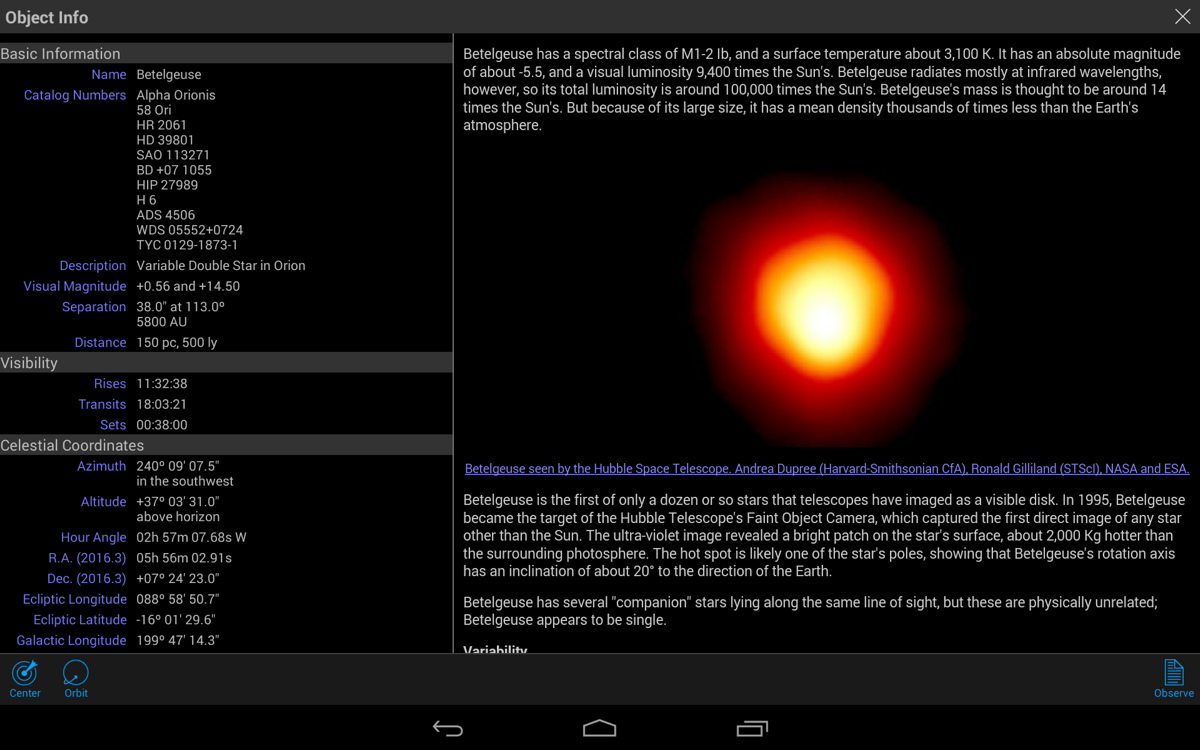
Pollux (or β Gem) is the orange colored K0III-type bright star that sits above Orion, close to its A2V-class partner Castor, which is about four finger-widths to the west. The pair of medium-bright stars marks the heads of the twins of Gemini. Pollux is burning at a surface temperature of 4,700 degrees K (8,000 degrees F or 4,427 degrees C). It's only about 34 light-years away and is somewhat larger than Earth's sun. Aldebaran, the bright-orange, baleful eye of Taurus the Bull, which sits to Orion's lower right, is another K-star. Over in the east is yet another K-star, summer's bright Arcturus, fourth brightest in the night sky.
While you can enjoy a G-star, Earth's sun, all day, another prominent one is visible every evening: the bright yellow star Capella in Auriga, the Charioteer. It is located high in the west in midevening, sitting above and between Orion and the W-shaped constellation Cassiopeia. Capella (or α Aur) actually consists of four stars in a tight arrangement at a distance of about 42 light-years from Earth, but the brightest two are G-stars (types G8III and G0III) whose surfaces burn at about 5,500 degrees K (9,440 degrees F or 5,227 degrees C). The others are two dim red-dwarf stars. Visually, you'll see a single bright point with a noticeable yellow hue.
Procyon (or α CMi) is the very bright, pale-yellow-colored F5IV-type star that sits east (to the left) of, and between, Pollux and Betelgeuse. It's in the two-star constellation of Canis Minor, the Little Dog, and is quite close to Earth, at only 11 light-years away. Polaris, the North Star, appears as a much dimmer, F-type star.
Speaking of dogs, friendly Sirius, sometimes nicknamed the Dog Star, marks the dog tag of Canis Major, the Big Dog. Sirius (or α CMa) is low in the southwestern sky this month, just below and to the east (left) of Orion. Sirius is the brightest star in the entire night sky, mainly because it is so close, at only 9 light-years away, and because it is a white-ot 9,900 degrees K (17,360 degrees F or 9,627 degrees C) A1V-type star. Pollux's partner Castor is another A-class star, as are summertime's bright Deneb and Altair stars. Sirius has a reputation for displaying a range of colors while twinkling, mainly due to its brilliance and position low in the sky, which means it is seen through a thicker blanket of atmosphere. For the most part, you should observe an intense white appearance. [The Nearest Stars to Earth (Infographic)]
Rigel (or β Ori), which marks Orion's western foot, is a bright, blue-white B8Ia-type star. Saiph, Orion's other foot, is another one, but dimmer. Rigel's surface blazes at a whopping 12,100 degrees K (21,320 degrees F, 11,827 degrees C) and shines extremely brightly despite its nearly 900-light-year distance. It's just as bright, but twice as far as Betelgeuse.
O-type stars are at the extreme end of the range. They burn hot and die quickly , in only 10 million years or so. Because they are so short-lived, they are also relatively rare. Orion's famous belt contains two O-class stars, Alnitak (or ζ Ori) on the east and Mintaka on the right. Alnitak, Arabic for "the girdle," is a hot, blue, supergiant star of class O9.7Ib, and is the brightest of its class in the night sky. In a large telescope under dark skies, the area around Alnitak is filled with glowing clouds of nebulosity.
Now that you know what to look for, try selecting some other stars that have various colors, and use your sky-charting app to find out if you guessed correctly. You'll soon be a pro. And with summer soon arriving, you'll have a new sky of stars to tour.
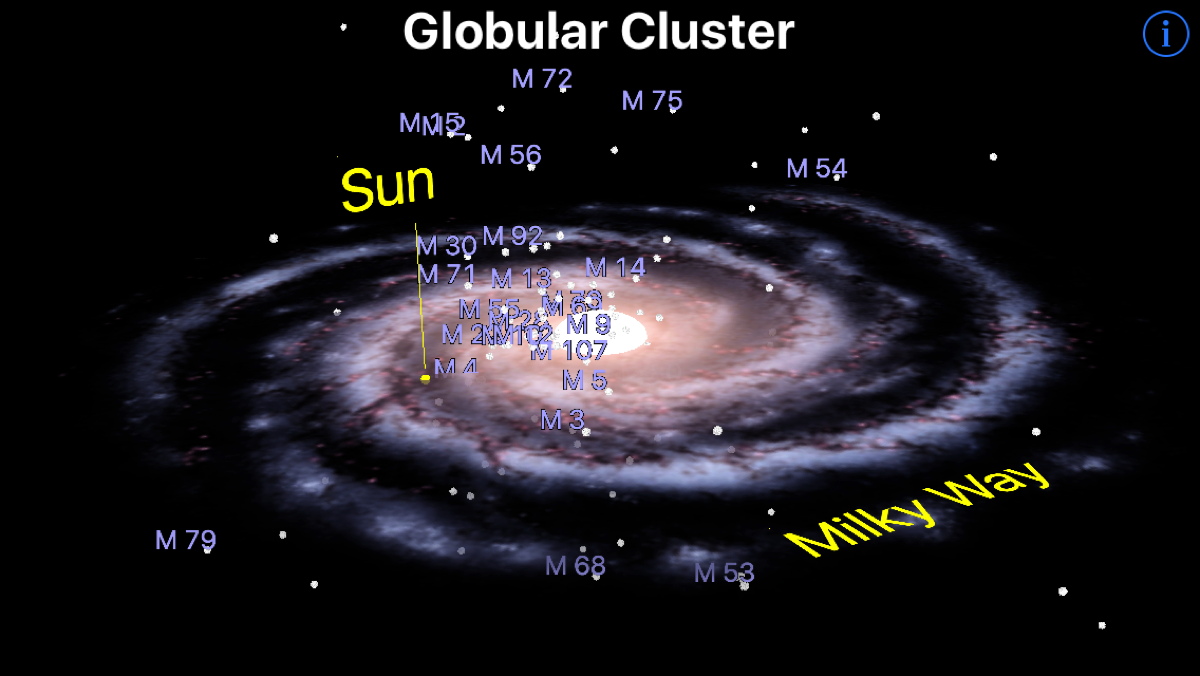
Going Beyond
If you are interested in learning more about the physics of stars, check out the Astrophysics II mobile app for iOS. The user interface is rather simple, but it contains some very nice visualizations and interactive demos. For example, the Light-Matter Interaction menu leads you to a page of simple physics about light. At the bottom of the section, a link labeled Black Body Radiation brings up a tool that you can play with to relate star color and temperature. At the bottom of the same section are some links bringing up pictures of stellar emission and absorption spectra. The Doppler Effect menu leads to a tool you can use to play with the blue and red shifting of starlight, depending on the speed of approach or retreat.
Scroll down in the Constellations menu to find animated star maps in which you can use a slider to show how the proper motions of stars will change the shape of the constellation over time, past, present and future. The Open Cluster menu has a 3D model of the Pleiades Star Cluster (also known as Messier 45) that you can rotate to see the different distances the stars are from Earth. Under Evolution of Stars, there's a submenu called Main Stars where you can see how the size and colour of each star compares to the sun, and read a description. There's plenty more, too: telescopes and optics, black holes, and binary stars. There's even a 3D model of the Milky Way galaxy showing Earth's location and the known globular clusters. I highly recommend you take a look, and it's a must for science teachers.
In our next column, we'll take a look at mobile apps for exploring Earth's nearest celestial neighbour, the moon. We'll examine the phases, eclipses, moon-map apps, and some lunar-exploration apps from NASA and other sources. Until then, keep looking up!
Editor's note: Chris Vaughan is an astronomy public outreach and education specialist, and operator of the historic 1.88 meter David Dunlap Observatory telescope. You can reach Chris via email, and follow him on Twitter @astrogeoguy, as well as Facebook and Tumblr.
This article was provided by Simulation Curriculum, the leader in space science curriculum solutions and the makers of the SkySafari app for Android and iOS. Follow SkySafari on Twitter @SkySafariAstro. Follow us @Spacedotcom, Facebook and Google+. Original article on Space.com.
Join our Space Forums to keep talking space on the latest missions, night sky and more! And if you have a news tip, correction or comment, let us know at: community@space.com.
Chris Vaughan, aka @astrogeoguy, is an award-winning astronomer and Earth scientist with Astrogeo.ca, based near Toronto, Canada. He is a member of the Royal Astronomical Society of Canada and hosts their Insider's Guide to the Galaxy webcasts on YouTube. An avid visual astronomer, Chris operates the historic 74˝ telescope at the David Dunlap Observatory. He frequently organizes local star parties and solar astronomy sessions, and regularly delivers presentations about astronomy and Earth and planetary science, to students and the public in his Digital Starlab portable planetarium. His weekly Astronomy Skylights blog at www.AstroGeo.ca is enjoyed by readers worldwide. He is a regular contributor to SkyNews magazine, writes the monthly Night Sky Calendar for Space.com in cooperation with Simulation Curriculum, the creators of Starry Night and SkySafari, and content for several popular astronomy apps. His book "110 Things to See with a Telescope", was released in 2021.


